Hygrophila pinnatifida is a plant that has been known for over than 150 years, although it had been cultivated as a tank plant only since 2008. However, up to now the plant is still rather rare species. Hygrophila pinnatifida is a captivating and versatile aquatic plant that originates from Southeast Asia. It belongs to the family Acanthaceae and is highly sought after by aquascaping enthusiasts for its unique appearance and growth pattern.
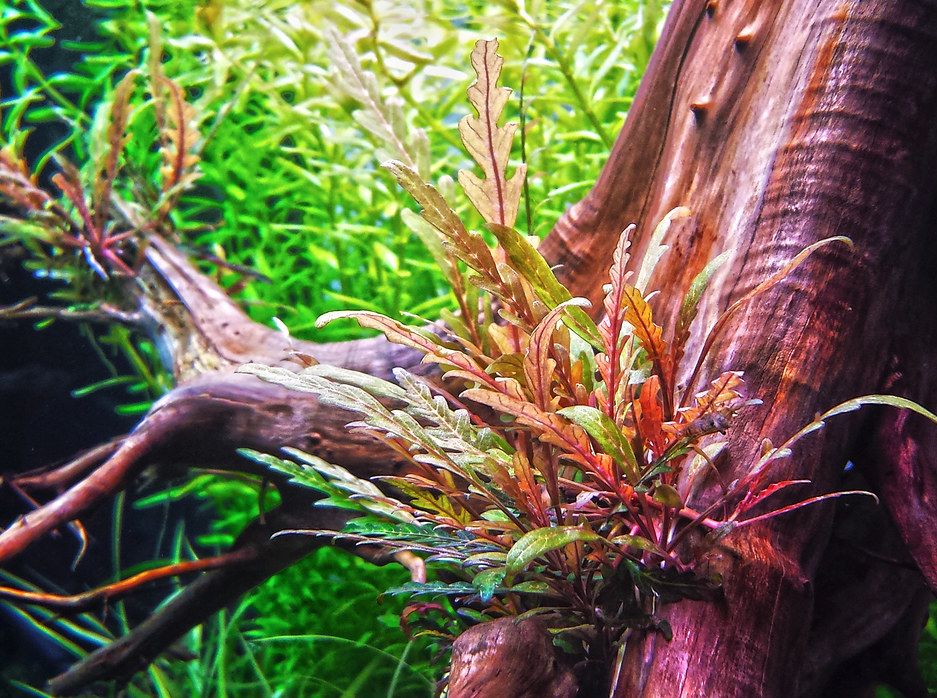
Contents
Plant Habitat in the wild
Hygrophila pinnatifida is native to the Southeast Asian region, specifically found in countries such as India, Bhutan, Nepal, and Bangladesh. In nature, it typically grows in aquatic habitats like streams, rivers, and marshes. Hygrophila pinnatifida is an aquatic plant that was brought to aquariums from India. There it grows in streams at the bottom of Western Ghats in the tideland.
Hygrophila pinnatifida is commonly found in shallow, slow-moving waters, both in submerged and emergent forms. It thrives in areas with moderate to high water flow and can be observed growing along the banks of streams or partially submerged in flooded areas.
In its natural habitat, Hygrophila pinnatifida prefers to anchor its roots into a substrate composed of nutrient-rich soil, sand, or gravel. The plant’s root system helps it firmly attach to the substrate, enabling it to withstand water currents and maintain stability.
In its natural environment, Hygrophila pinnatifida exhibits a creeping or sprawling growth habit. The stems grow horizontally along the water surface or substrate, producing lateral shoots and forming dense patches of foliage. Its ability to spread and propagate laterally aids in its natural reproduction.
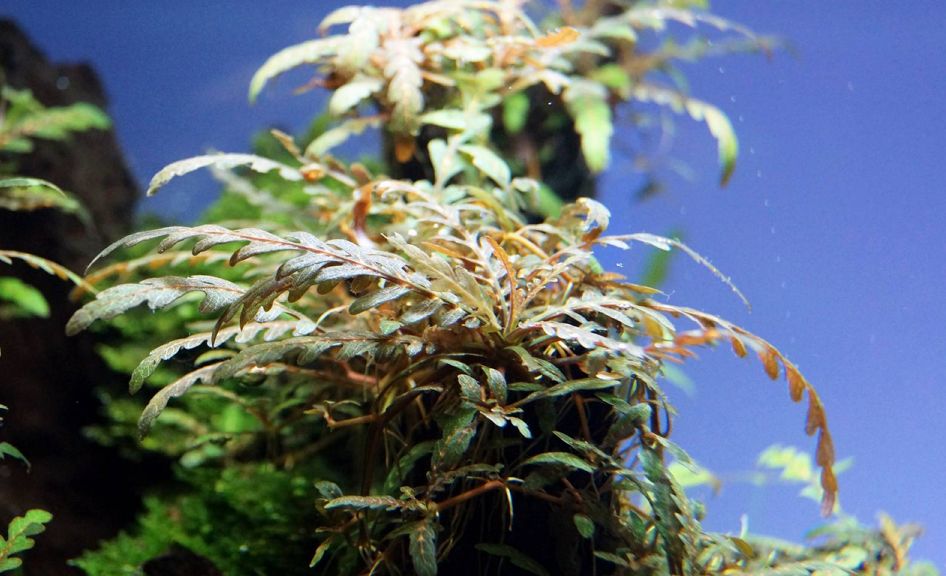
Description
Like ferns and anubias species Hygrophila pinnatifida easily sticks to stones and snags with its roots, which is actually not common at all for long-stalked tank plants. Besides, new shoots of this plant eagerly trail over the substrate and each their internode strikes roots in it like a ground-covering tank plant.
Then each rooted verticil shoots an upright stem which then can also incline to towards the tank bottom.
This plant typically grows in an upright manner with creeping stems that spread horizontally. It can reach a height of 15-40 cm (6-16 inches) and develop lateral shoots from the main stem. Over time, it forms dense and lush foliage, creating a visually appealing effect in the aquarium.
Hygrophila pinnatifida has long dedalous leaves (up to 6 inches long). Coloring of the leaf front side may vary from dark green to brown, while its bottom side is always pink. The stem is thick, solid and almost stiffen. Hygrophila pinnatifida’s pinnate leaves, with multiple lobes or segments, allow for increased surface area, optimizing the absorption of sunlight and carbon dioxide. The lobes or segments vary in size and shape, giving the plant an intricate and textured appearance. The leaves are relatively stiff and can create a captivating contrast when paired with softer plant species in aquascapes. The leaves have a finely serrated or toothed edge, which helps reduce drag and damage from water flow.
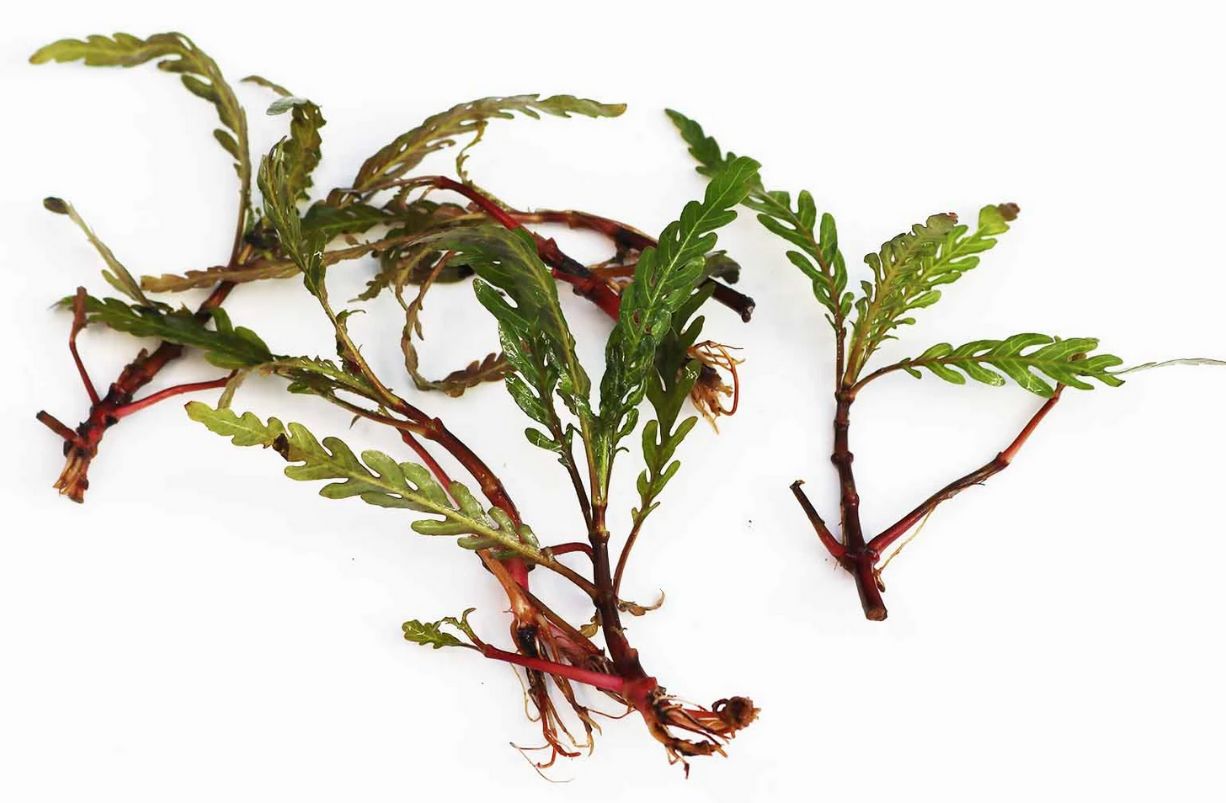
| Characteristic | Hygrophila pinnatifida |
|---|---|
| Common Name | Hygrophila pinnatifida; hygro pinnatifida |
| Origin | Southeast Asia |
| Growth Rate | Moderate to Fast |
| Height | 15-40 cm (6-16 inches) |
| Leaf Shape | Pinnate |
| Leaf Color | Green to Reddish-Brown |
| Lighting Requirements | Moderate to High |
| CO2 Requirements | Beneficial, but not essential |
| Water Temperature Range | 20-28°C (68-82°F) |
| pH Range | 6.0-7.5 |
| Hardiness | Moderate to High |
| Propagation | Cuttings, Lateral Shoots |
| Placement | Foreground, Midground, Background |
| Suitable for Beginners | No |
| Versatility | Suitable for Various Aquascaping Styles |
| Benefits | Adds Texture and Depth to Aquascapes |
| Challenges | Can Grow Tall and Require Frequent Trimming |
| Interaction with Fauna | Provides Shelter and Foraging Grounds |
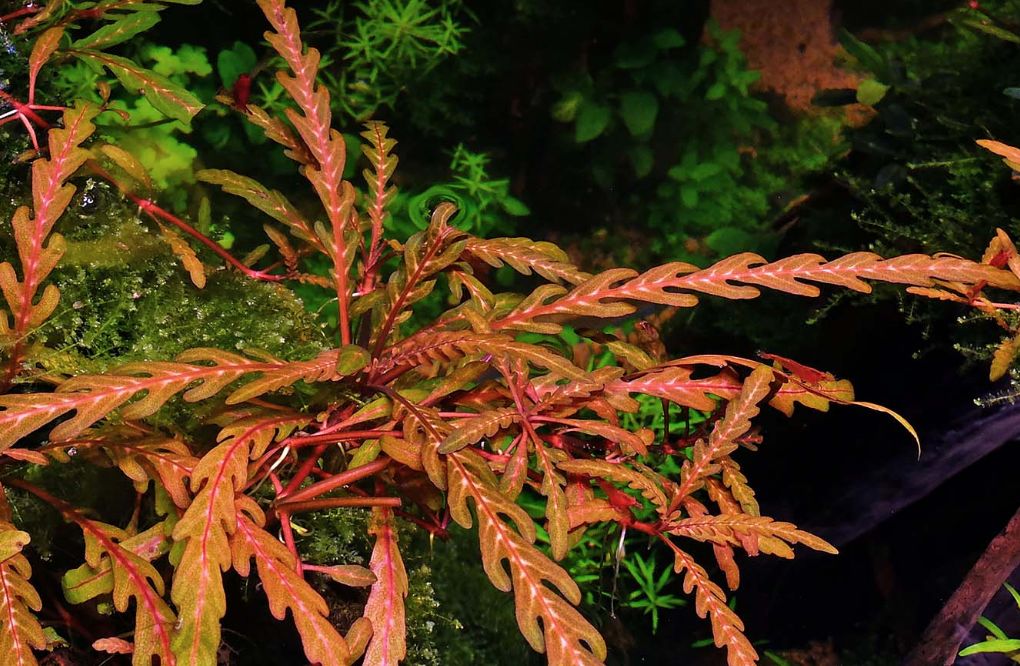
Difficulties in keeping
Hygrophila pinnatifida successfully grows provided with moderate light. However, at intense illumination the plant size becomes smaller. To stimulate this transformation you should regularly trim its shoots.
It is recommended to add sufficient amount of nutrients into the tank water as well as CO2. This Hygrophila species is very sensitive to lack of potassium in the water. Its absence shows when small round holes start to appear in the old leaves of the plant.
Keeping in a tank
We should mention, that the plant demonstrates its best habitus provided with ideal tank conditions – it becomes bushy, reddish colored and you can form bushes from it if you trim it properly. At the same time Hygrophila pinnatifida can grow in amateurs tanks as well (without CO2 supply, intense illumination etc.).
In this case the plant becomes greenish colored and tends to grow upwards. Often at such conditions you may see small holes in the leaves of the plant, which indicates lack of potassium in the tank water.
The plant growth rate depends on the tank conditions and the stage of its growth. At moderate illumination as well as limited amount of nutrients and CO2 in the water, Hygrophila pinnatifida grows and reproduces quite slowly.
But provided with intense lighting and sufficient amount of nutrients and CO2, its vertical shoots may reach the water surface quite quickly. In this case, you should trim the shoots regularly.
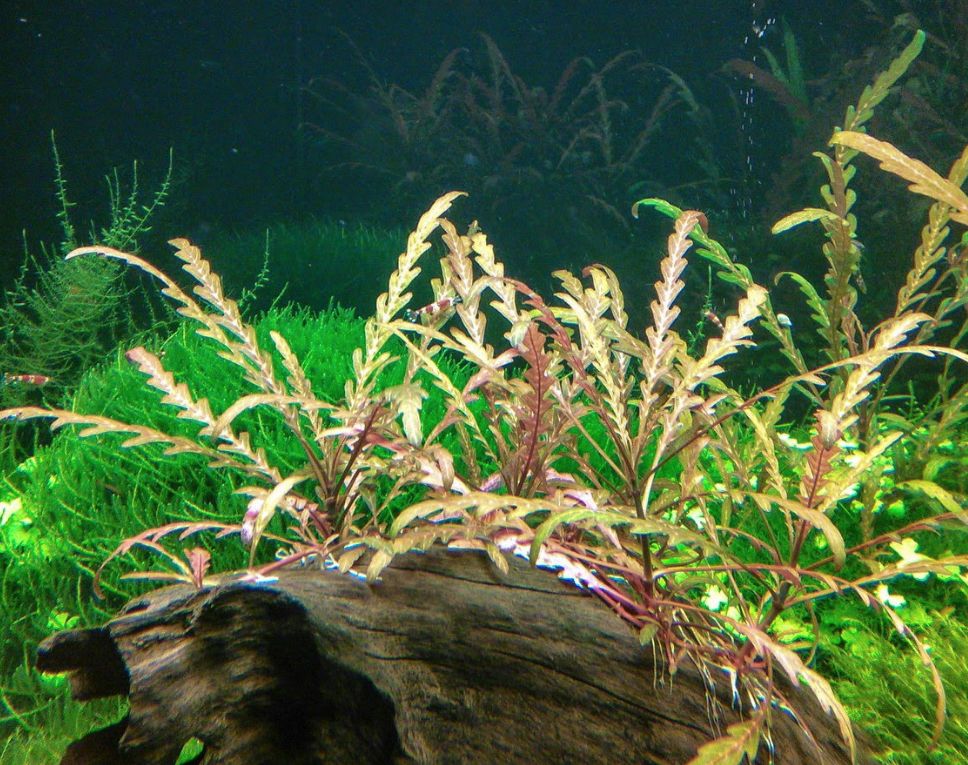
Lighting
Hygrophila pinnatifida thrives under moderate to high lighting conditions. Ensure that your aquarium has appropriate lighting fixtures, such as LED lights, to provide sufficient light intensity. Aim for around 2-3 watts per gallon or follow the manufacturer’s recommendations.
Aim for a photoperiod of 8-10 hours per day. Providing a consistent and appropriate amount of light each day helps maintain a stable environment for Hygrophila pinnatifida.
If the plant grows at natural light, it starts to bloom, usually it happens in spring.
Water Parameters
Hygrophila pinnatifida is adaptable to a range of water parameters. It prefers a water temperature of 20-28°C (68-82°F) and a slightly acidic to slightly alkaline pH range of 6.0-7.5. The plant can tolerate varying water hardness levels but generally prefers soft to moderately hard water.
CO2
While not mandatory, supplying supplemental CO2 can enhance the growth and vibrancy of Hygrophila pinnatifida. It will benefit from CO2 injection, especially in setups with higher light levels. Consider a CO2 system to maintain optimal carbon dioxide levels in the aquarium.
Nutrients
Hygrophila pinnatifida benefits from nutrient-rich water. Regularly supplement your aquarium with essential nutrients, including macronutrients (nitrogen, phosphorus, and potassium) and micronutrients (iron, magnesium, and trace elements).
Like all Hygrophila species, this one is demanding only in terms of potassium content in the tank water. Therefore, additional supply of potassium is a must in most of cases, otherwise old leaves of the plant get covered with small round holes.
Substrate
As for the substrate, its type is completely insignificant for the plant, since Hygrophila pinnatifida forms quite small and not very deep growing root system. If you take the plant out of the ground, you will see that substrate grains or sand got stuck to the plant roots.
If you keep plant in a wet substrate, provide it with sufficient amount of light and fertilizers, you may grow the emersed form of the pant. Its leaves will gradually become wider and shorter as well as get greenish coloring; the stems will grow upwards.
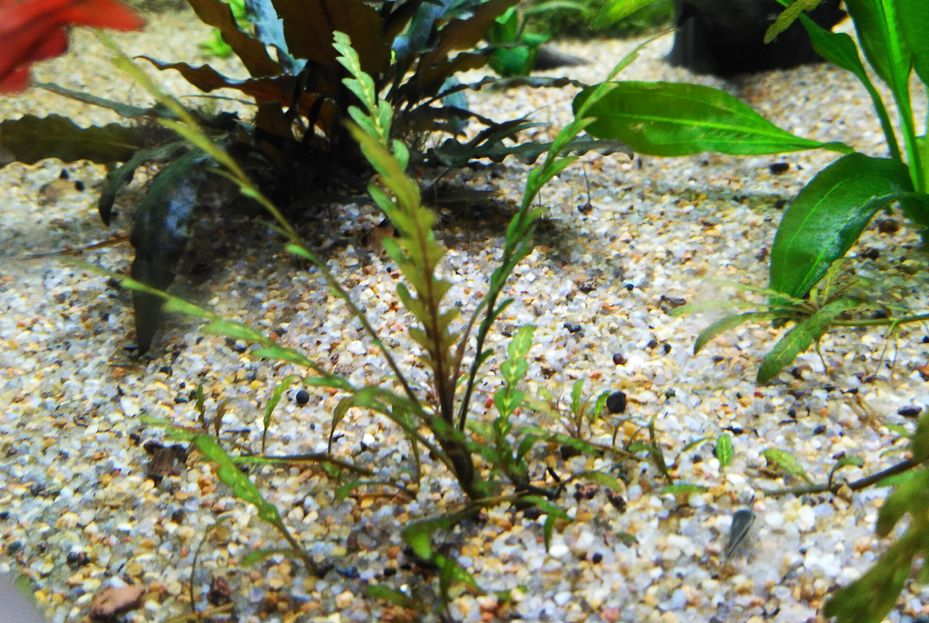
Planting
Hygrophila pinnatifida can be grown as an epiphyte, meaning it can be attached to surfaces such as rocks, driftwood, or other decorations in the aquarium. Planting Hygrophila pinnatifida on driftwood or rock can create an attractive and natural-looking aquascape in your aquarium.
Take small portions of Hygrophila pinnatifida and attach them to the driftwood. You can use cotton thread, fishing line, or plant-friendly glue (Super glue) to secure the plant to the wood. Make sure the roots of the plant are in contact with the driftwood.
Place the driftwood in the desired location within the aquarium. Consider the plant’s lighting requirements and the overall aquascape design. Ensure that the attached Hygrophila pinnatifida has sufficient access to light and water flow.
Hygrophila pinnatifida planted on driftwood will benefit from regular nutrient supplementation. Provide essential macro and micronutrients through liquid fertilizers or root tabs. Follow the manufacturer’s instructions for proper dosage and application.
Propagation
The plant is cultivated mainly by cutting. After you trim plant, it actively forms a lot of side branches where it was cut. Provided with favorable conditions the plant forms horizontally growing shoots, that easily strike roots.
- Stem Cuttings:
- Select a healthy stem of Hygrophila pinnatifida that is at least a few inches long.
- Using clean and sharp scissors or pruning shears, cut the stem just below a node (the point where leaves or lateral shoots emerge).
- Remove the lower leaves from the stem, leaving a few intact at the top.
- Plant the cutting into the substrate, ensuring that at least one node is buried. You can use tweezers to gently push the stem into the substrate to avoid damaging the plant.
- If desired, you can use weights or plant weights to keep the cutting in place until it develops roots.
- Provide suitable lighting, nutrient-rich water, and maintain optimal water conditions to promote root development.
- Over time, the cutting will develop roots and start growing as an independent plant.
Sources: